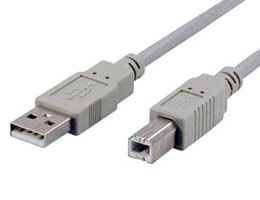What are USB Connectors?
One Standard, Many Connectors
USB connectors are the link that makes communication between your device and computer possible via a cable. They are placed on each end of the cable and not all connectors are the same. The type of connector depends on the device and the location of the connection. A connector plugs into a USB socket or port, which is built into the device as well as your computer. Plugs are meant to work with matching sockets.
There are two primary connectors, and these are further broken down into size categories. They are mostly either Type A or Type B, and they can be male or female.
Type A Connectors

Type A connectors are characterized by a wide and flat rectangle shape. They are easily recognized since they are the connection used for USB flash drives, as well as printers, scanners, and other similar devices. Its flat contacts help keep it plugged in and is outfitted with an inner plastic component that helps guide users with insertion in the proper orientation. They connect to computers or hubs, supplying a downlink stream.
Type B Connectors
The Type B USB plug has a thicker, somewhat rounded square shape. It stays inserted into a socket with the help of friction from its contacts. These types of connectors plug into devices to load data or power, therefore acting as an upstream connection.
Connectors become smaller and more specific with their function but are still based on the A and B idea. They were a response to smaller devices entering the market.
Mini USB Connectors
Mini A and B USB connectors have been deprecated by USB-IF since mid-2007 in part because they complicated the amount of connections consumers had to use. Their functions were to provide power or data for smaller devices like phones or cameras.
The Mini-B plug is a 5-pin connector that is the only standardized plug of its kind accepted by the USB-IF. However, some manufacturers have created smaller 4-pin models for the connector of their own products.
The standard Mini-B is a smaller version of its type B predecessor. It is used in a variety of cell phones, digital cameras, and other devices. They can also be implemented with the USB On-The-Go connection, which links devices together.
Micro USB Connectors

Micro USB connectors were announced just months before Mini-A and Mini-AB connectors were no longer certified. They solely provide a male connection and have since enjoyed widespread adoption for its one-size-fits-all concept, especially when it comes to charging mobile phones.
A Micro-USB A connector handles high speed transfers and On-The-Go for smartphones, digital cameras, GPS devices, and more. It can withstand more wear and tear than a Mini plug.
A Micro-USB B plug gives an upstream connection for small portable devices.
The gray Micro-USB AB connector is multipurpose in that it can perform both A and B functions, either down streaming power or upstreaming data. It uses 5 pins, just like a Mini connector, but On-The-Go devices make up the connection’s primary location.
USB 3.0 SuperSpeed Connectors

USB 3.0 refers to the industry standard for the USB technology. Specifically, USB 3.0 refers to the transfer speed available. See here for more details about USB 3.0.
There are basic USB 3.0 connectors with male only plugs: USB 3.0 Type A, Type B, and Micro-B connectors. The Type A USB 3.0 looks like its 2.0 counterpart with a flat, wide connector that points to the computer or hub. Its down streaming capabilities work not only with a SuperSpeed interface, but also with USB 2.0 and 1.1 (i.e. it’s backwards compatible). They differ in appearance only in the blue markings which makes distinguishing them easier for users.
USB 3.0 Type B connectors and cables are for SuperSpeed devices and can transfer data and power. They will not work with older interfaces but are compatible with their cables. A Micro-B USB 3.0 connector will also carry data and power at a SuperSpeed rate, but works conversely to the Type B USB 3.0 connector. This blue connection is located on 3.0 devices, but Micro-B cables will not work with older devices.
Type C Connectors

The Type C connector has significantly changed the course of how previous devices used to connect. It has an oval shaped connector. With a much higher output, Type C USB connectors are used for more than just data transfer. They can store data but also are sturdy enough to power laptops and other larger devices. They have impressive bi-directional power capability. Simply put, Type C USB connectors allow host devices to charge peripheral devices and vice versa. Eventually, type A USB connectors will be replaced with Type C, which consolidates data transfer and power into one port type.
